This very year I have recommended 6 great books already, now I bring you 10 more I hope you like. Hello there everybody, glad to be back with my new post about my favorite subject here, that is books.

“So many books, so little time.” ― Frank Zappa
Last year 2022 was one of my most productive years in the reading department.
I read 20 books in total; I haven’t read that much since 2010.
My interests in reading focus mostly on fiction, but I also tend to include a variety of subjects.
I always make time in my days for reading, it is one of my priorities and should be one of yours too.
On this list you will find 6 novels; one is from a cult writer famous for his drunkenness; one is a short but fiery classic of the 19th century; two of them are from two celebrated Jewish authors, both published in the first decade of this 21st century; the next one is the best science-fiction novel I have ever read; and the last one is an extraordinary family tale set in the Poland of the 19th century by a Nobel Prize winner and one of the most underrated authors of all time.
You will find also two of the best biographies ever published; the first one is about the most celebrated artist of the 20th century and the second one is a rigorously account of the short life of one of the great gods of rock n’ roll.
You will find also a terrific collection of short stories by a great British author and, to complete this list, a classic philosophy book written in the 1600s which until this day remains widely read and very influential.
Like in most of my recommendation posts I will describe first the plot of the book and later give you some facts and thoughts about it.
So, without further ado, let’s begin:
10 - Hollywood – Charles Bukowski (1989)
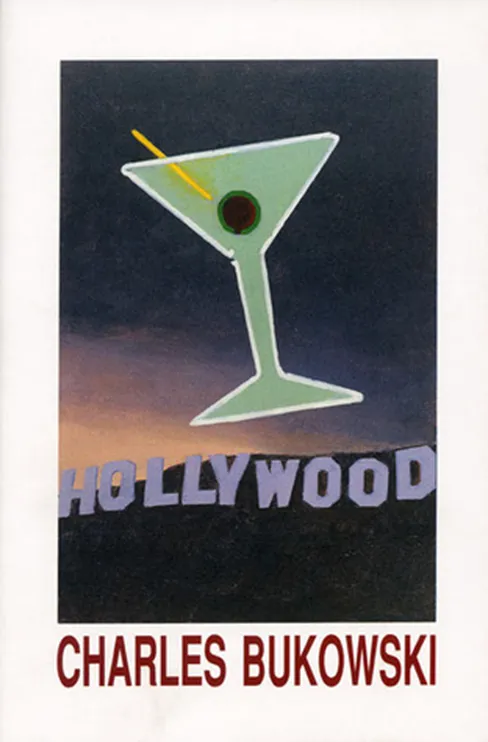
A cover of Hollywood (via: goodreads.com)
"Look, Jon, if I cared about what people are interested in, I'd never write anything." – Hollywood
One day in the 1980s, an eccentric movie director has the idea of making a movie about the tales of dirty drunk old man Henry Chinaski and Chinaski, reluctantly, agrees to write a script which he finishes quickly. Things start to get in motion. Chinaski receives good money for his script and, at the age of 65, buys his first property and a BMW. He takes his woman and leaves the seedy neighborhood full of blacks and Mexicans he was living in. He spends his time between the production of the movie, going to horse races, writing poems and, of course, drinking lots of booze. But, before and after the movie starts its production, lots of problems will also come along for all of those involved in the project.
What will follow will be a wild nightmare that Chinaski will deal with his ironic sense of humor and wondering what can he get out of it. Lots of obstacles, a cool but whimsical actor, an aging actress desperate to revive her career and to show off her perfect legs; parties, beach houses, rich people, lots of drugs and alcohol, annoying lawyers, interviews, photo shoots and even a hunger strike just to get a movie made. A work of art that in the end it’s all about contracts, business and money.

Faye Dunaway, Charles Bukowski and Mickey Rourke on the set of “Barfly” (via: grotesqueground.wordpress.com)
Hollywood was Bukowski’s fifth novel and the funniest he ever wrote. Although not as good as his previous ones, still delivers a good story, told in a funny ironic way, that will open your eyes about the difficult and dirty movie business of Hollywood. It is Bukowski’s take on how Barfly (1987) was made, with Jon Pinchot as Barbet Schroder, Jack Bledsoe as Mickey Rourke and Francine Bowers as Fay Dunaway. I read once that Bukowski is the author you love in your twenties, hate in your thirties but you take him back in your forties. Definitely, check this one out, it has all the elements you crave in a Bukowski story and will give you a few laughs and a good time. By the way, if you haven’t seen Barfly, well, you must.
9 - A Set of Six – Joseph Conrad (1908)
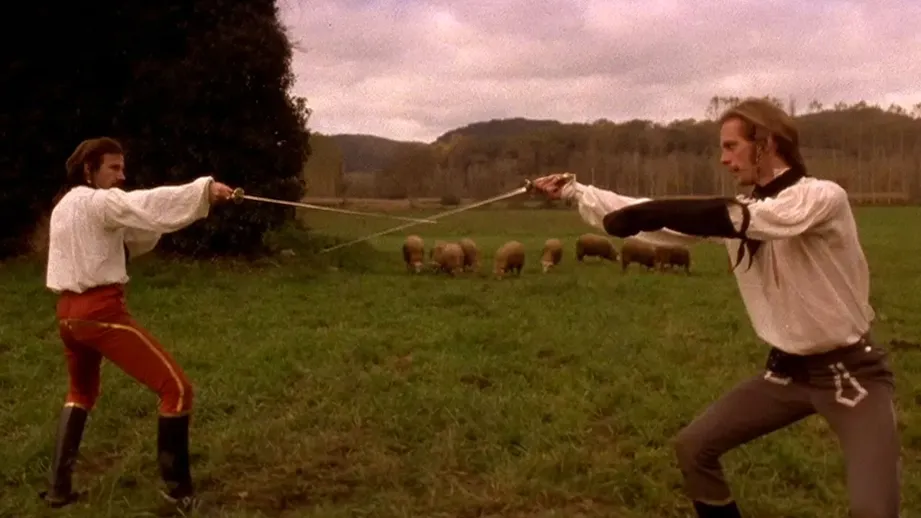
Harvey Keitel and Keith Carradine in Ridley Scott’s "The Duellists" (1977) (via: google.com)
“My task is to make you hear, to make you feel, and, above all, to make you see. That is all, and it is everything.” ― Joseph Conrad
The six tales that make this splendid book are, somewhat, all based in true stories. In Gaspar Ruiz, you will learn about a strange warlord and his tragic ending during the South American independence war against Spain. Il Conte is an anecdote of a distinguished French count who goes to Naples because “Vedi Napoli e poi mori” only to be found himself victim of the mafia. The Informer and An Anarchist are about real-life conversations and points of view; The Brute is about a ship that seems to be cursed. And finally we have the largest, the best and my favorite, The Duel, about the rivalry of two officers of La Grande Armée during the Napoleonic Wars, who after a stupid incident, spend the next ten years or so of their lives fighting in several duels.

Joseph Conrad in 1916 (via: commons.wikimedia.org)
These six tales were published in different magazines and finally put together in this book, published in 1908. All of them have a good quality, with The Duel, Il Conte and Gaspar Ruiz being the best of them. A book I bought a long time ago, but didn’t read completely until last year. Ridley Scott did a good version of The Duel for his first movie in 1977, but that movie had a failed ending; if it would have stuck to the excellent short story it was based on it would have been so much better. A very good collection you have to check out, but, I warn you, Joseph Conrad can get difficult at the first try, hell if I should know, I started reading The Duel, my favorite of these, three times before finally reading it until the end. So, be patient and when you finish reading anything from him, Conrad will become one of your favorites.
8 - Discours de la méthode – René Descartes (1637)

Johannes Vermeer – The Geographer (1668) (via: commons.wikipedia.org)
“The reading of all good books is like conversation with the finest men of past centuries.” – Discours de la méthode
René Descartes spent 9 years going around, travelling, observing, being more of a spectator than an actor in life, just to challenge his thinking and develop his philosophy. More than changing the world, he proposed not to interfere and, at the same time, try to understand it because maybe God made the world as it should be. God is or exists, He’s a perfect being, and everything is us proceeds from Him. A country must have just a few set of laws, but these few most be strictly obeyed. A man who is not useful to others has no value, but, sometimes, a man must sacrifice his work for his contemporaries if what he’s working for will benefit the future generations. Descartes set some basic rules for himself: Not admitting as truth nothing that is not evident; divide every difficulty in small parts, always go from simple to complex. We are all creatures who think, Cogito ergo sum: I think, therefore, I am.

Frans Hals – Portrait of René Descartes (1649) (via: wikipedia.org)
Born in France in 1596, René Descartes, a philosopher and a mathematician, was one of the most celebrated personalities of his time. Between 1612 and 1616, he studied Philosophy at La Flèche and Law at the University of Poities; in 1618, he enrolled in the Dutch army. In 1619, while in Neuburg, he started to develop his own philosophy. He inherited enough money to live independently and travelled through France, Germany and Switzerland and established himself in The Netherlands where he would stay for the next 20 years. In 1637 he published Discours de la méthode, he went later to publish several other philosophy books. He became popular and exchanged correspondence with other personalities of the time. Although a strict catholic, he was involved in controversies with the Catholic Church, particularly the Jesuits. He went to live in Stockholm in 1649 after receiving an invitation from Queen Christina of Sweden, but the Swedish weather proved to be fatal to his health. Descartes died one year later. In 1667 his remains were taken to Paris.
René Descartes is considered the founder of modern Philosophy. Discours de la méthode was the first Philosophy book written in French and is still widely read; it remains one of the most influential works in the history of Philosophy.
7 - The Book of Illusions – Paul Auster (2002)

A cover of The Book of Illusions (via: publishersweekly.com)
“It seems to me that I will always be happy in the place where I am not.” ― Paul Auster
What is real and what is not? After losing his family in an airplane crash, David Zimmer, a college Literature professor, becomes a shadow of himself. In a state of depression, considering suicide, he just spends his days at home drinking alone with his thoughts. Then, one day, he finds himself laughing at a silent black and white movie he finds by chance on TV. He’s also intrigued by the protagonist of the movie, Hector Mann, a Jewish actor born in Argentina that had lots of odd jobs before moving to Hollywood and becoming a star just to disappear one day without leaving any trace. Zimmer starts researching and publishes a book about Hector Mann. Then he receives a call from a mysterious woman who tells him Hector Mann is still alive. What will come next will be a story of lies, deception, weird sex, odd jobs, a new life, romance, a murder and even a suicide. Then, David Zimmer will have to decide what to do with all he has seen and lived through.

(Via: pixabay.com)
A novel that was very-well received in the early 2000s, won several awards, but had been somewhat forgotten since. Paul Auster, born in 1947, crafted with this one an excellent novel, a good story about guilt, innocence, lies, labyrinths of memoires, multiple identities, death and sorrow. Like all Jewish authors, Auster writes about other Jewish characters, particularly men who are depicted as sexual beings with a tragic fate. A book that is worth reading, but I’m not sure if I would like to read again. It is Auster’s last good novel, all the others that came after this one have been received with mixed to bad reviews. I don’t know about you, but I’ll stick to the great New York Trilogy.
6 - Life with Picasso – Françoise Gilot and Carlton Lake (1964)
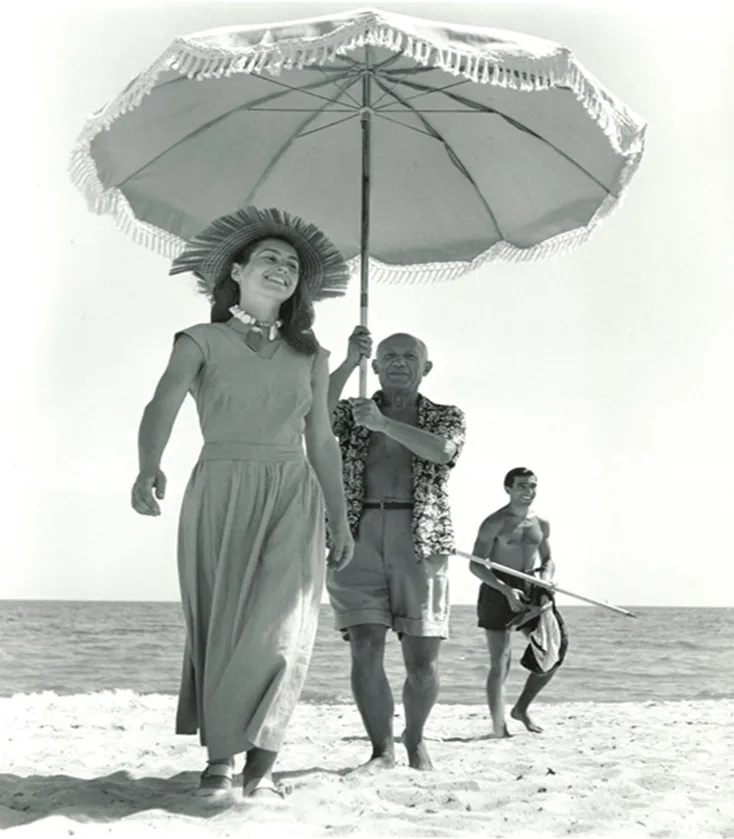
Robert Capa, Pablo Picasso & Francoise Gilot, Golfe-Juan, France, August, 1948 (1948) (Via: aperture.org)
“When there is something to steal, I steal it.” – Pablo Picasso
In the Paris of May 1943, during the German occupation of France, the young aspiring painter Françoise Gilot met the great artist Pablo Picasso; she was 21, he was 62. Six months later she would move with him to his house in the Rue des Grands-Augustins. Françoise would become Picasso’s apprentice, muse and lover. Their relationship would last for 10 years, Picasso produced countless of works; they had two children. In this wonderful biography, Gilot describes with great detail rich anecdotes of the artist, his eccentricities, his phobias, and fears, his bad relationship with his eldest son, his vacations in the French Midi, his believes and his extraordinary capacity for work and concentration. A slew of peculiar characters of real life also appear in this book: Henri Matisse, Braque, Joan Miró, Marc Chagall, Dora Maar, Paul Éluard, all of whom played a part in Picasso’s life. Picasso never read books, never went to the movies or the theater, didn’t know how to drive a car and worked intensively for eight hours every day. Françoise Gilot would learn a lot from him until, tired of Picasso’s difficult character, she ended up leaving him in 1953.

Gilot and Picasso (via: BBC.com)
Pablo Picasso may be the most prolific, productive and experimental artist that has ever existed. At his death in 1973, at age 92, he had created more than 30,000 works of art. But he was also a difficult person with many contradictory beliefs, full of eccentricities, all of which contributed to leave a permanent mark in all the people who knew him. We have to thanks Françoise Gilot, a splendid artist herself, for leaving us this extraordinary document about her life with the great artist; it is probably the best biography ever written about an artist. Gilot and art critic Carlton Lake researched extensively to produce this work. Most of the things we know about Picasso’s life would still be unknown to us if it wasn’t for this book.
Picasso used all his power to stop this book from being published; he also tried to prevent Gilot from exhibiting her works. Francoise Gilot went to become a renowned artist of the 20th century. In an eight-decade career of she produced more than 1,000 paintings; she also wrote poetry, married 4 times, lived in New York City but made frequent travels to France. She didn’t allow her book Life with Picasso to be used as basis for the 1996 film Surviving Picasso, starring Anthony Hopkins as Pablo Picasso. She died on June 6, 2023, at age 101 in New York City. May she rest in peace.
5 - No One Here Gets Out Alive – Jerry Hopkins and Danny Sugerman (1980)

“Mr. Mojo Risin’” (via: whatculture.com)
“Cancel my subscription to the resurrection” – Jim Morrison
The man the world would know a Jim Morrison, the front man of the mythical American rock band The Doors, was born in 1943 as James Douglas Morrison and by the time of his death, at age 27, had lived a life must people in this world would kill to have lived. More than a rock singer and an alcoholic, he was also a songwriter, a poet, an amateur filmmaker, a voracious reader and somewhat of a philosopher. A man with a brilliant talent who rejected authority, did lots of drugs and always pushed things to the limit just to see what would happen next.
The son of a Rear Admiral of the US Navy and a homemaker, he grew up on military barracks, traveled all over the world, experimented with drugs and witchcraft, fucked groupies, had troubles with the law, had to stand for a couple of trials, wrote poetry, became a rock n’ roll god, just to end his life in 1971 in a mysterious and tragic death after a drug overdose. “The Lizard King”, “Mr. Mojo Risin’” is now bigger in death that in life. He will never be forgotten.

The Doors in 1967 (via: mediafeed.org)
Full of rich and shocking details, this brilliant biography was the product of seven years of thorough research. When it was first published, in 1980, it rocketed to the number one position on the New York Times best-seller list, remaining there for nine months. Both authors knew Jim Morrison in real life and had written other works about Elvis Presley and Guns n’ Roses. While on the road in New Mexico as a kid, Jim Morrison suffered an experience that would alter his life forever. He was obsessed with the Greek myths, admired the works of Jack Kerouac and the poetry of Arthur Rimbaud; his favorite philosopher was Friedrich Nietzsche. He never owned a house and spend most of his life living in hotel rooms and rented apartments; he only drove American cars. He wrote two poetry books, had a mysterious wedding with a witch, had affairs with multiple women, but always went back to his only love, Pamela Courson, his “cosmic mate”.
He left The Doors after a six-record deal was complete; by that time he was a shadow of his former self always drinking alcohol, because that’s what alcoholics do. Only five people were present at his funeral in Paris in 1971 and his mysterious death has always been the subject of stupid conspiracy theories, none of which have ever been proved. No One Here Gets Out Alive is the best biography ever written about a rock star.
4 - The Humbling – Philip Roth (2009)

A cover of The Humbling (via: goodreads.com)
“Everybody else is working to change, persuade, tempt and control them. The best readers come to fiction to be free of all that noise.” ― Philip Roth
Suddenly, at age 65, Simon Axler, a famous Jewish theater actor, loses his ability, his self-confidence and his magic… he cannot act on stage anymore. He submerges in a depression which causes his life to fall apart. His wife leaves him, his manager can’t convince him to go on stage again. He goes to live in a small town where, by chance, he meets a young woman that will revive his joy for life; but this woman is a lesbian with an egotistic personality. And just when Simon thought things would work out for him again, the story of his life will take a major turn that will cause a bleak and sad destiny for him.

Philip Roth in the 2010s (via: spiked-online.com)
At the time of his death, Philip Roth (1933-2018) was considered the best living writer in the world. He published his first book in 1959 and became world-wide famous thanks to the neurotic masturbation story Portnoy’s Complaint in 1969. In 1997 he won the Pulitzer Prize for American Pastoral. At the end of his career he managed to produce a slew of excellent short novels and The Humbling is the best of them. Published in 2009, Roth’s slender thirtieth novel received critical praise for his mastery in prose. All elements of the classic Roth are here: irony, talent, women, love, sex, passion, hope, betrayal, Judaism and desperation. You won’t believe how good this short novel is. The story of an actor who loses his talent will shock you and stay in your mind, a story that proves why Roth was a master of literature. RIP Philip Roth.
3 - Taras Bulba – Nikolai Gogol (1835)
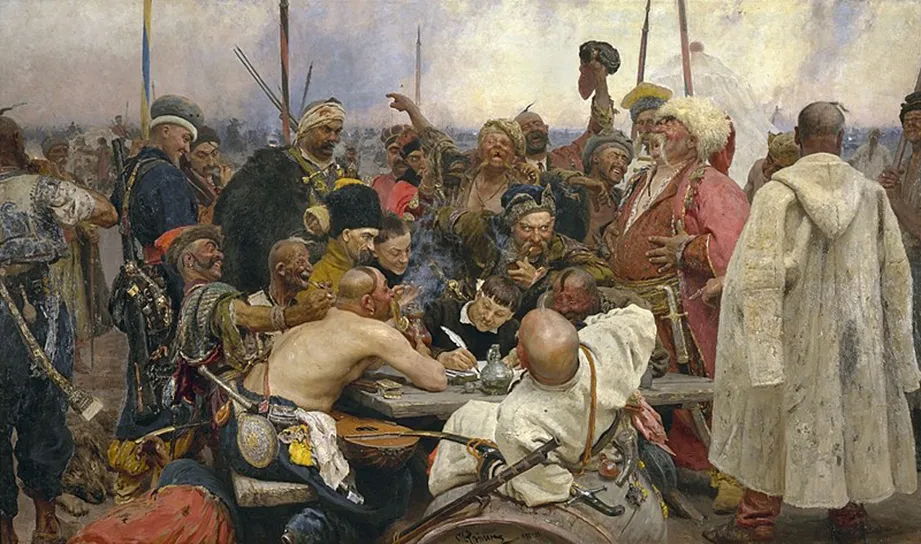
Ilya Repin – Reply of the Zaporozhian Cossacks (between 1878 and 1891) (via: commons.wikimedia.org)
(Taras Bulba, the leader of the Cossacks, is the fat guy laughing at the right with walrus-like mustache, a hat, a pink robe and a sword at his waist)
“There is hardly a bigger pleasure than a pleasure to create.” – Nikolai Gogol
The Old Ukrainian Cossack Taras Bulba welcomes his two sons, the tough Ostap and the handsome Andriy, both return home after completing their training at the Kiev Academy. It’s the 1500s, wild days for Western Europe; The Ukraine is fighting a war for its independence against Poland. Although a truce has been agreed, the old Taras loves war and is anxious to start fighting and killing again. He persuades the Cossacks to break the truce and the combats resume against the Poles. Despite his hatred for the Jews, Taras will also befriend a Jew named Yankel whose help will always come in handy. And then, one day, Andriy will fall in love and marry a beautiful Polish girl and will join the ranks of the Poles against the Cossacks. Dismayed by this betrayal, the old Taras will also suffer another tragedy that will set his anger in motion. He will become the scourge of the Poles doing what he does best: pillaging, looting and killing. When he is finally captured, the old Taras Bulba will still have something to save his Cossacks in the end.
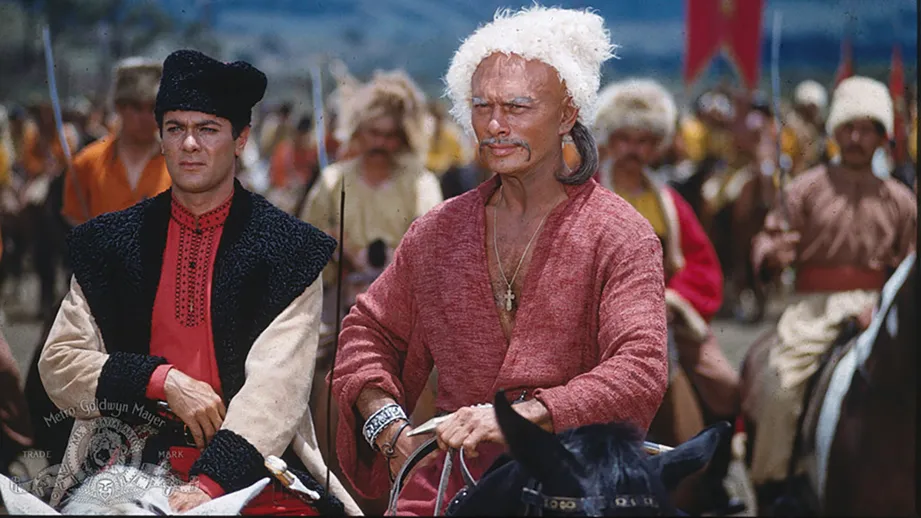
From left to right: Tony Curtis as Andriy and Yul Brynner as Taras Bulba in a 1962 adaptation of the novel. (Via: google.com)
The Ukrainian Cossacks have been some of the toughest men that have ever existed in this world, and here you have their best story ever put in writing. Nikolai Gogol (1809-1852) wrote this novella between 1833 and 1842. He based the character of Taras Bulba in several Ukrainian Cossacks; since then, Taras Bulba has become a legendary character in literature, representing the courageous Ukrainian people who have always been at fight for its country and freedom. The beautiful descriptions of the Ukrainian Steppe, combined with the wild combats of the Cossacks and strong characters, make this a well-written story with patriotic themes you won’t forget. There have been several movie adaptations, operas and references in pop culture to this great character.
I read Taras Bulba for the first time in 2006 and several other times ever since. It has become something of a ritual for me to read it every December. Short, tough, violent, beautiful and magnificent at the same time, it’s a book every man must read (and reread) in his lifetime.
2 - 2001: A Space Odyssey – Arthur C. Clarke (1968)
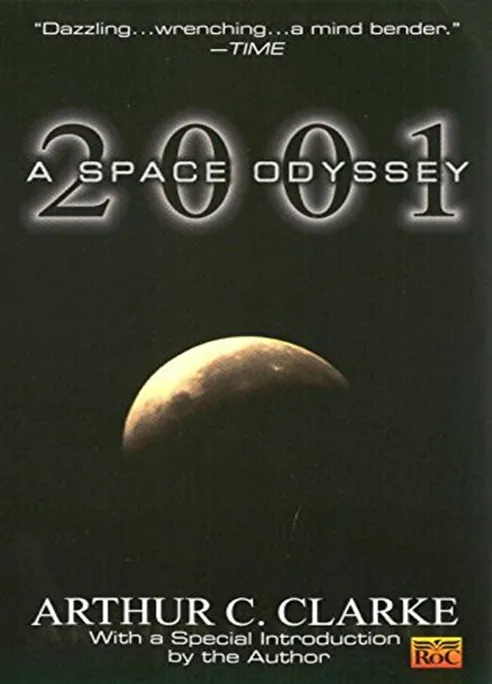
A cover of the novel (via: goodreads.com)
“The limits of the possible can only be defined by going beyond them into the impossible.” – Arthur C. Clarke
Divided into six sections, this hallucinating novel will take you from the origins of mankind to life well beyond the stars. One day, millions of years after the disappearing of dinosaurs, Moon-Watcher, a humanoid-monkey, and his tribe struggle to find water in the African plains. Then, a mysterious tall dark rock appears in the ground; some time later Moon-Watcher will learn how to build a tool with his hands, the first weapon in history and this simple discovery will mark the greatest leap forward in the evolution of mankind.
Millions of years later, a group of scientists discover the same tall rectangular monolith, this time on the moon. Later, Bowman, an astronaut on board of the Discovery ship on its way to Saturn, will have to face the computer HAL-9000 who wants to eliminate all human life on board. Bowman will find later the same mysterious monolith floating in space, this will signal another extraordinary voyage through the stars and possibly the next step in the evolution of the being we call man.
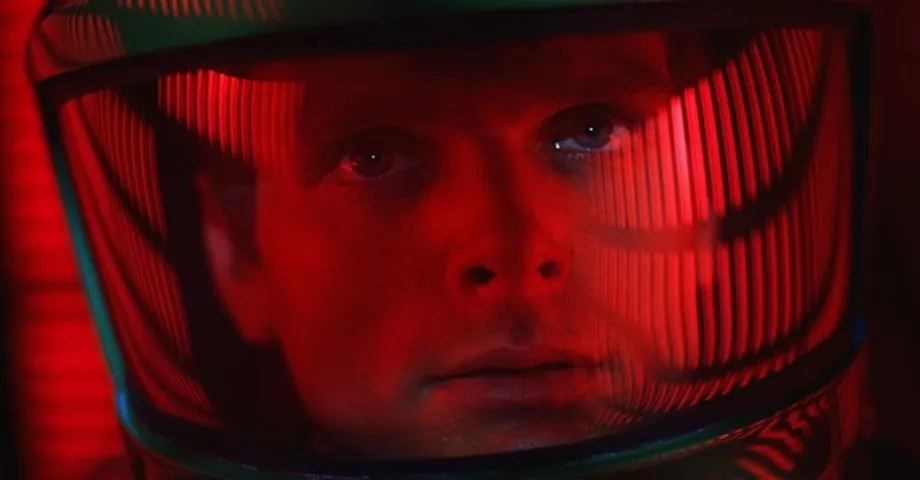
A still of the 1968 Kubrick’s adaptation (via: whatculture.com)
If you have seen the extraordinary movie based on this novel by Stanley Kubrick (and I hope you have seen it), you may have some confusions and a lot of questions, well, in this book you will have the answers to those and a little more. Published in 1968, this novel writes about what we should have been dong decades ago: keep exploring the vast universe. It is space exploration that represents the next step in the evolution of man; we should have never stopped going to the moon. Man is a curious being by nature, it is in his very core to explore and find out what’s out there. This very-well written novel will open your imagination about all the possibilities of man and what can be accomplished in we put our minds together once more to find out what’s out there. As a science-fiction fan myself, I can tell you this is the best science-fiction novel I have ever read in my life.
1 - The Manor – Isaac Bashevis Singer (1967)

A cover of The Manor (via: halooglasi.com)
“Life itself is a permanent crisis” – Isaac Bashevis Singer
It’s the 1860s, the Russians have invaded Poland and have crushed a recent rebellion; many are hanged, others are deported to Siberia. The Jewish people that used to be confided in ghettos are set free and start integrating to the Polish society. Calman Jacoby, a 40 something Jewish trader, soon gets to live in the manor that used to belong to a noble count; he has a loving wife and four daughters. He soon starts several businesses and becomes a rich man. But his riches don’t bring him joy, his employees rob him, the Poles speak badly about him, the corrupt Russians want their share, his loving wife dies and one of his daughters, Miriam Lieba, runs away to Paris with Lucian, a man wanted by the Russians, the son of the noble man whose house Calman lives in. Calman will later marry a bad woman named Clara, together they will conceive a despicable son named Sasha; then, Clara will betray Calman with another man she takes as her lover.
And Poland starts to develop like never before; factories, roads, buildings are built at an impressive speed. But the Jewish people still hold fiercely to their own traditions. Tired and overwhelmed by all of his problems, Calman will find solace in his old Jewish faith.
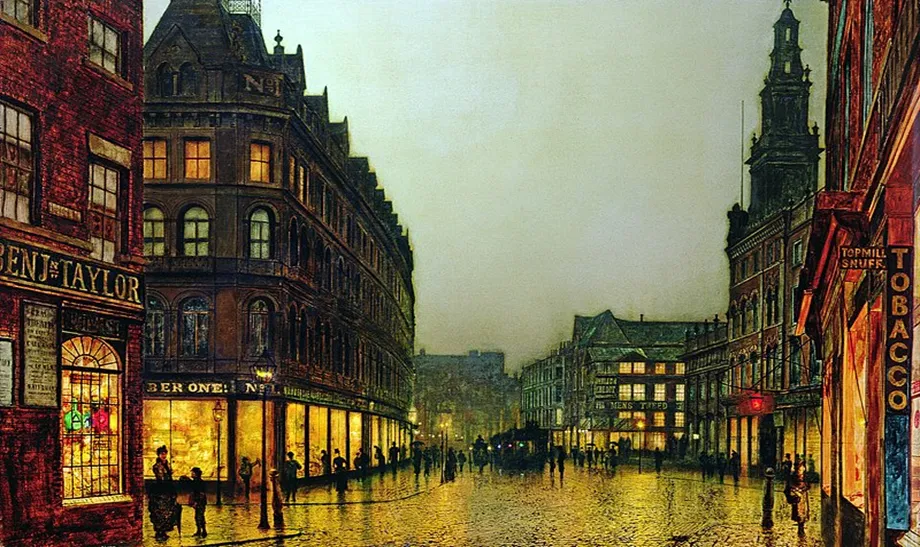
John Atkinson Grimshaw – Boar Lane, Leeds (19th Century) (via: Wikipedia.org)
Isaac Bashevis Singer was born in 1904 in the Poland occupied by the Russians. He published his first novel in 1935, later he migrated to the United States and became popular through his short stories collections. He was awarded the Nobel Prize of Literature in 1978. The Manor, published in 1967, was written in Yiddish between 1953 and 1955. In this extraordinary novel you will find the paradoxes of life, relationships, family, religion and a people who want to keep their traditions intact in a world that is changing like never before. It is one of the best novels about the subject of the family I have ever read and the descriptions of the 19th century are the most impressive you will ever read. Warsaw and Paris are the main cities where this superb story takes place. The second part of this novel, The Estate, published in 1969, concludes the story in an amazing way. I have read both of these books like seven times each and will continue to do so. Isaac Bashevis Singer must be one of the most amazing and underrated writers of the 20th century. He died in Miami in 1991.
So there you have it friends, 10 great books I recommend you to read as soon as you can. Have you ever read any of these books? Which one do you want to read first? Do you have another book recommendations you want to share with us? If so, leave them in the comments below.
Don’t forget to follow my blog for more content like this one.
Now, check the 10 best books I read in 2021 here:
@thereadingman/here-they-are-the-10
Thank you for stopping by, please share this post and don’t forget to upvote!
Until next time
Take care
Orlando Caine